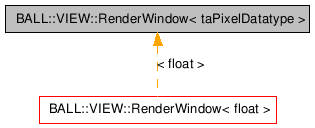BALL::VIEW::RenderWindow< taPixelDatatype > Class Template Reference
General rendering window interface. More...#include <renderWindow.h>

Public Member Functions |
|
| virtual bool | init () |
| virtual bool | resize (const unsigned int width, const unsigned int height) |
| Request new window size. |
|
| virtual void | refresh () |
| Request that the image is actually
displayed on the screen or other device the window
encapsulated. |
|
| virtual FrameBufferPtr | getBuffer () throw (BALL::Exception::NoBufferAvailable) |
| virtual FrameBufferFormat | getFormat () const |
| virtual void | releaseBuffer (FrameBufferPtr buffer) |
| virtual void | prepareRendering () |
Protected Attributes |
|
| t_PixelPtr | m_pixels |
| FrameBufferPtr | m_framebuffer |
| FrameBufferFormat | m_fmt |
| const PixelFormat | m_pfm |
| bool | m_bufferLocked |
| const unsigned int | m_minimalWidth |
| const unsigned int | m_minimalHeight |
Detailed Description
template<typename taPixelDatatype>
class BALL::VIEW::RenderWindow< taPixelDatatype
>
General rendering window interface.
Such a window represents a surface on a screen or other device, where a buffer encapsulated by RenderTarget interface can be displayed
Member Function Documentation
| virtual void BALL::VIEW::RenderWindow< taPixelDatatype >::refresh | ( | ) | [virtual] |
Request that the image is actually displayed on the screen or other device the window encapsulated.
You should implement this method in subclass. This is different from RenderTarget releaseBuffer. ReleaseBuffer only informs the window that a buffer is ready, but does not imply the buffer is actually displayed somewhere. This is done by refresh. On the other hand, refresh called inbetween getBuffer and releaseBuffer has no effect.
Reimplemented in BALL::VIEW::GLOffscreenTarget, and BALL::VIEW::GLRenderWindow.
| virtual bool BALL::VIEW::RenderWindow< taPixelDatatype >::resize | ( | const unsigned int | width, | |
| const unsigned int | height | |||
| ) | [virtual] |
Request new window size.
Returns false if such a size cannot be supplied This call must be made before the window buffer is handed out to be rendered. This precondition is being checked automatically, see getBuffer
Reimplemented in BALL::VIEW::GLOffscreenTarget, and BALL::VIEW::GLRenderWindow.
 1.5.8
1.5.8